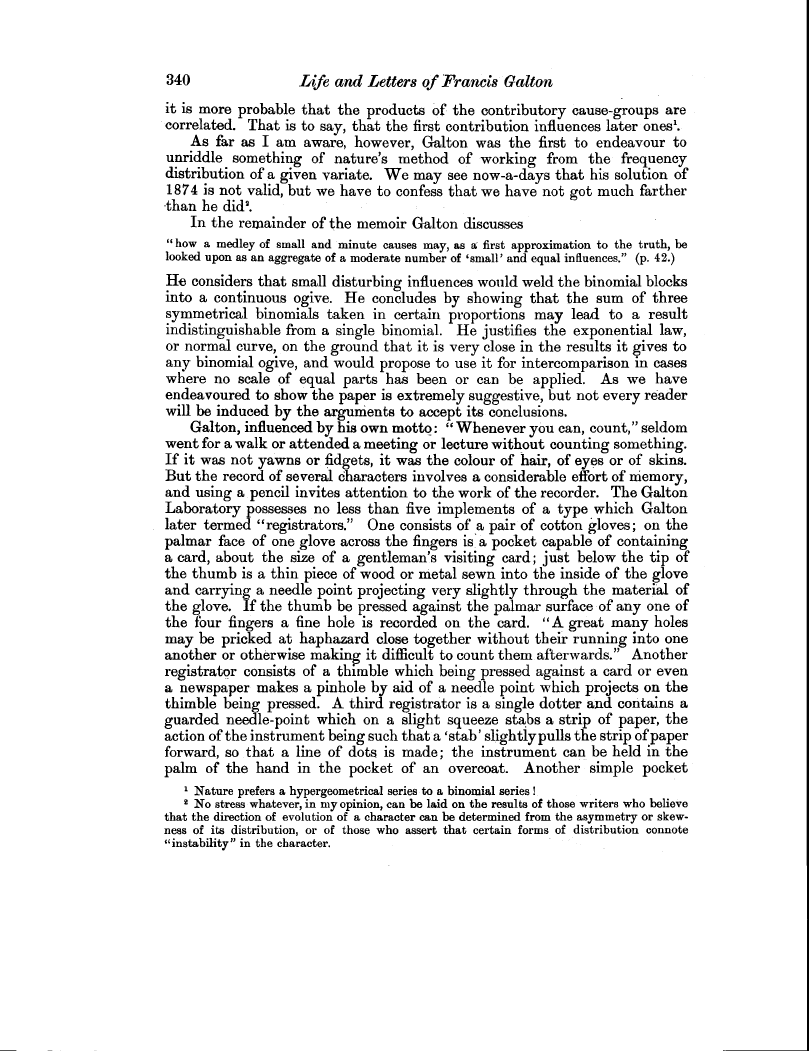340 Life and Letters of Francis Galton
it is more probable that the products of the contributory cause-groups are correlated. That is to say, that the first contribution influences later ones'.
As far as I am aware, however, Galton was the first to endeavour to unriddle something of nature's method of working from the frequency distribution of a given variate. We may see now-a-days that his solution of 1874 is not valid, but we have to confess that we have not got much farther than he did'.
In the remainder of the memoir Galton discusses
" how a medley of small and minute causes may, as a first approximation to the truth, be looked upon as an aggregate of a moderate number of 'small' and equal influences." (p. 42.)
He considers that small disturbing influences would weld the binomial blocks into a continuous ogive. He concludes by showing that the sum of three symmetrical binomials taken in certain proportions may lead to a result indistinguishable from a single binomial. He justifies the exponential law, or normal curve, on the ground that it is very close in the results it gives to any binomial ogive, and would propose to use it for intercomparison in cases where no scale of equal parts has been or can be applied. As we have endeavoured to show the paper is extremely suggestive, but not every reader will be induced by the arguments to accept its conclusions.
Galton, influenced by his own motto: " Whenever you can, count," seldom went for a walk or attended a meeting or lecture without counting something. If it was not yawns or fidgets, it was the colour of hair, of eyes or of skins. But the record of several characters involves a considerable effort of memory, and using a pencil invites attention to the work of the recorder. The Galton Laboratory possesses no less than five implements of a type which Galton later termed "registrators." One consists of a pair of cotton gloves; on the palmar face of one glove across the fingers is 'a pocket capable of containing a card, about the size of a gentleman's visiting card; just below the tip of the thumb is a thin piece of wood or metal sewn into the inside of the glove and carrying a needle point projecting very slightly through the material of the glove. If the thumb be pressed against the palmar surface of any one of the four fingers a fine hole is recorded on the card. "A great many holes may be pricked at haphazard close together without their running into one another or otherwise making it difficult to count them afterwards." Another registrator consists of a thimble which being pressed against a card or even a newspaper makes a pinhole by aid of a needle point which projects on the thimble being pressed. A third registrator is a single dotter and contains a guarded needle-point which on a slight squeeze stabs a strip of paper, the action of the instrument being such that a `stab' slightly pulls the strip of paper forward, so that a line of dots is made; the instrument can be held in the palm of the hand in the pocket of an overcoat. Another simple pocket
1 Nature prefers a hypergeometrical series to a binomial series !
2 No stress whatever, in my opinion, can be laid on the results of those writers who believe that the direction of evolution of a character can be determined from the asymmetry or skewness of its distribution, or of those who assert that certain forms of distribution connote "instability" in the character.

